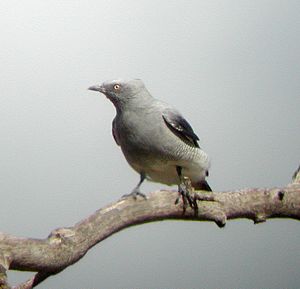Ground cuckooshrike facts for kids
The ground cuckoo-shrike (Coracina maxima) is a special bird found only in Australia. It's not very common. You can mostly find it in open forests and dry grasslands in Australia's inland areas. Sometimes, it's also seen on the east coast.
Quick facts for kids Ground cuckoo-shrike |
|
|---|---|
 |
|
| Conservation status | |
| Scientific classification | |
| Genus: |
Coracina
|
| Species: |
maxima
|
Contents
About the Ground Cuckoo-shrike
The ground cuckoo-shrike belongs to a bird family called Campephagidae. There are 81 species in this family worldwide. Seven of these species live in Australia.
The ground cuckoo-shrike is part of a group called Coracina. This group includes cuckoo-shrikes, cicadabirds, and trillers. These birds live in Africa, Asia, Australia, and islands in the Pacific Ocean.
In Australia, there are four types of cuckoo-shrikes:
- The black-faced cuckoo-shrike is very common and found all over Australia.
- The white-bellied cuckoo-shrike is less common. It lives in northern Australia, Queensland, Victoria, and eastern New South Wales.
- The barred cuckoo-shrike is rare. It's found along the east coast of Queensland and parts of New South Wales.
- The ground cuckoo-shrike is uncommon and lives only in Australia. You can find it in most Australian states and territories.
What Does It Look Like?
The ground cuckoo-shrike is a thin bird with long legs. It's the biggest cuckoo-shrike, growing to about 33–37 centimeters long. It weighs around 115 grams.
The name "cuckoo-shrike" comes from its features. It has a strong, hooked beak like a shrike. Its feathers look similar to a cuckoo bird. But it's not related to either of them!
Adult Birds
Adult ground cuckoo-shrikes have a light grey head and upper body. They have a black mask around their pale yellow eyes. Their lower back, rump, and belly are white with thin black stripes. Their wings and forked tail are black. The forked tail is a special feature only found on the ground cuckoo-shrike.
Young Birds
Young ground cuckoo-shrikes look a lot like the adults. However, they have thin, broken black stripes on their throat and upper body. Their eyes are dark, and they have a dark line around their eyes instead of a black mask.
Sounds and Flight
This bird has a unique call that sounds like ‘pee-ew, pee-ew’ or ‘chill-chill….kee-lik, keelick’. When they fly, their black and white colors can make them look a bit like an Australian magpie.
Where Do They Live?
Ground cuckoo-shrikes are found across many parts of Australia. This includes Queensland, New South Wales, South Australia, Western Australia, the Northern Territory, the Australian Capital Territory, and some areas of Victoria.
They mostly live inland, away from the coast, in Australia's dry regions. They prefer open woodlands, dry shrublands, and grasslands. These areas often have dead trees and plants like mulga, cypress-pine, and mallee-spinifex.
Ground cuckoo-shrikes are more likely to be found in these habitats if they are close to water. This means places like floodplains, creeks, and wetlands. Because of this, they are seen more often inland than near the coast.
Even though they live in many places, they are not very common. They are spread out and tend to move around. This makes it tricky to know exactly where to find them. The number of ground cuckoo-shrikes seems to be going down.
Ground Cuckoo-shrike Behaviour
What They Eat
As their name suggests, ground cuckoo-shrikes mostly find their food on the ground. Their long legs help them run quickly to catch food. They spend a lot of time searching for food on open ground in small groups.
They are insectivores, meaning they eat mainly insects. Their diet includes adult insects and their young. They eat things like praying mantis, grasshoppers, locust, ants, and spiders.
Breeding and Nesting
Ground cuckoo-shrikes are usually seen in small groups of three or more birds. This might be because young birds stay with their family until the next breeding season. Sometimes, these older young birds even help feed the new babies.
They build their nests on tree branches or in tree forks. These nests are usually 3 to 15 meters high. They use bark, grass, stems, and other materials to build them. Sometimes, they use old nests made by magpie-larks or white-winged choughs.
The breeding season is from August to November. The birds form pairs and lay between two and five eggs in the nest. Sometimes, more than one female will lay eggs in the same nest during the same breeding season. The eggs are a shiny olive color with brown or reddish-brown marks.
Conservation Status
Even though the number of ground cuckoo-shrikes is decreasing, their conservation status is currently listed as "least concern." This means they are not considered to be in immediate danger globally. However, in Victoria, Australia, they were listed as "vulnerable" in 2013.
One possible threat to these birds is the increase in thick woody plants. While this might help some woodland birds, it could harm the ground cuckoo-shrike. They prefer open woodland habitats, so too many dense plants could make it harder for them to live there.
See also
 In Spanish: Oruguero terrestre para niños
In Spanish: Oruguero terrestre para niños


